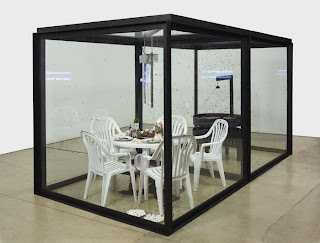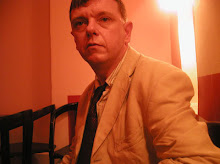It all started with that latrine, you know the one, originally cast to be just another receptacle in the privies of Paris. Then in 1917 it was re-cast by Duchamp to take centre stage in a revolution. He signed it, interestingly not with own his name, and boldly declared that anything can be art. This simple act created a seismic shift in the world of sculpture which still resonates today.
The exhibition begins from 1920 just three years after
Duchamp's ‘Fountain’ and ends at more or less the present day. It tracks the vibrant and creative the freedom the 20th Century released and also pin points, to my mind at least, the place where it all started to go wrong. More about this later.
The first rooms feature works by Barbara Hepworth, Eric Gill and Jacob Epstein next to their ancient, long dead influences. These artists flocked to the Victoria and Albert and British museums and drew on the powerful, passionate and raw influences they found and re interpreted them for a modern world. You can also clearly see the creative touchstones of Picasso’s genius pick-and plunder-and-mix approach to painting and sculpture. It was he after all that said ‘Great artists steal. ‘
The next room contains the single alabaster sculpture of Jacob Epstein’s ‘Adam’.
To me, Epstein represents Adam just seconds after nibbling on the forbidden fruit. Here we see him, awakened, head thrown back and charging smartly through Eden hunting down his Eve. Sporting, it has to be said, a vast, swinging, bludgeoning member. She, as yet unseen, pretending to run away!
The twin set and pearls crowd were stopped in their tracks. The shock of knowing where to look delivering the all too familiar ‘not knowing where to look’ feeling. Adam proudly uncaring shooed them into the next room only to be met by Queen Victoria, her un-amused face staring directly over our heads back at Adam. Surely this positioning was deliberate?
Adam and Victoria stare each other down
Click to see larger
Moving through, you will find ceramics followed by a room containing a single work by Henry Moore and another by Barbara Hepworth. Moore’s is a reclining, writhing androgynous figure and Hepworth’s a sharply worked stone facial silhouette. Both these pieces were created in the 1950s and you can see in both a desire to communicate to the whole of post-war Britain. A naive, optimistic place where they hoped to make it fit for heroes with a long awaited national health service and the Grammar schools which were soon to deliver us Alan Bennett, Mike Leigh and a fistful of Prime Ministers. Although these pieces are ‘accessible’ (now a dirty word) they are still challenging. They urge you to look again at the human figure and relook at the shapes and emotions we all exhibit and perform. ‘What am I like?.. really?’
Moore and Hepworth
Click to see larger
Where it goes wrong
Someone far smarter than me once said “You don’t just leave a job! You go to one”. Here, to me at least, there seems to be an abandonment of the figure in sculpture. Which is fine, but it needed to be replaced with something worthwhile. This to me (with the very rare example) has not happened.
This is the stage of exhibition where the visitors become more interesting than the exhibits. Here we have the ubiquitous pile of bricks by Carl Andre who is American anyway, which is snappily entitled ‘Equivalent VIII’. The visitors stand before it. Children snigger and adults squint and become confused and throw each other glances for re assurance as if to say ‘Tell me what to think’.
The highlight of the room was naturally Damien Hirst. He delivered to us a sealed glass room containing an abandoned BBQ with raw meat scattered about. In amongst this were thousands of flies and maggots feasting on the rotting food. Subsequently these flying, hapless exhibits were being lured in by an ultra violet light before finally succumbing to the merciless appetite of an eclectic insect killer.
The Hirst BBQ
Click to see larger
Like the footballers of today who once got buses to the match with their fans but now distance themselves from the plebs in monstrous cars with blacked out windows, here too the artists have distanced themselves with the smoke and mirrors of alleged intellectuality. This made all the more obvious with the sublime beauty of Moore and Epstein just meters away.
I suppose many will say that the great creative tide of the late 20th century has completely washed over me. I have disappeared beneath the waves while above Cap’n Emin and Boson Opie ride high and dry down Dean Street for another celebratory rum ration at Grouchos. I don’t feel like that. I feel like the tide has gone out to an arid scratch on the horizon and I’m sitting on the abandoned beach sniffing a latrine and only Damien’s flies for company.
Now there’s a painting!
Exhibition runs from:
22nd Januray to the 7th April
Royal Academy of Arts
Burlington House
Piccadilly
London W1J 0BD
Royal Academy of Arts opening times
10am-6pm Saturday-Thursday (last admission to galleries 5.30pm)
10am-10pm Friday (last admission to galleries 9.30pm)
liamofarrell.com










